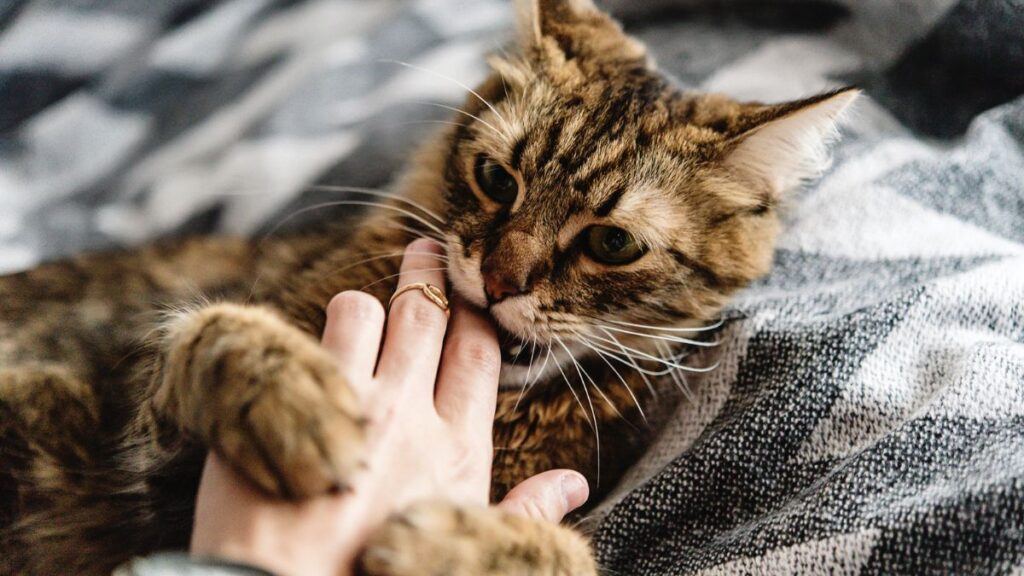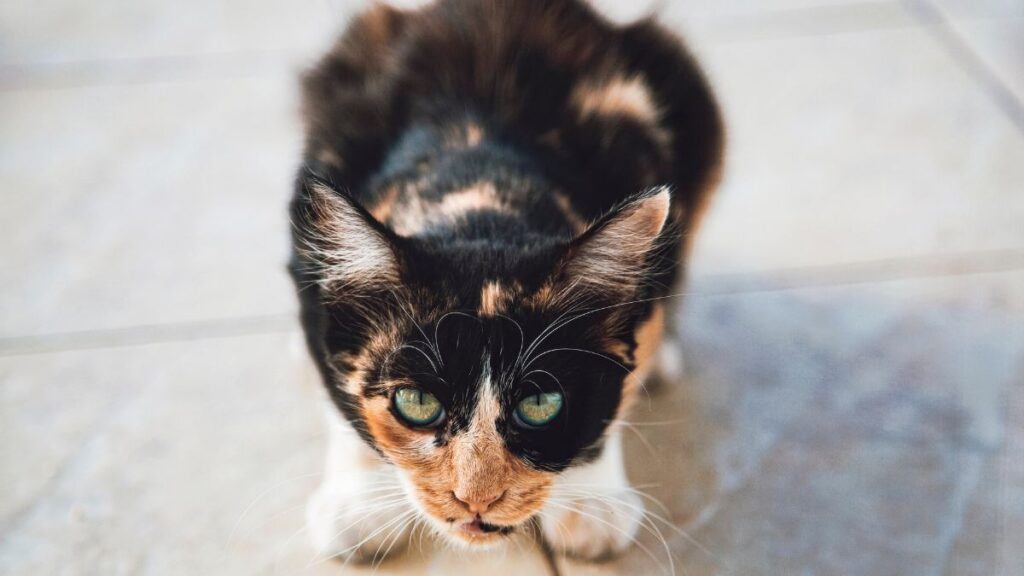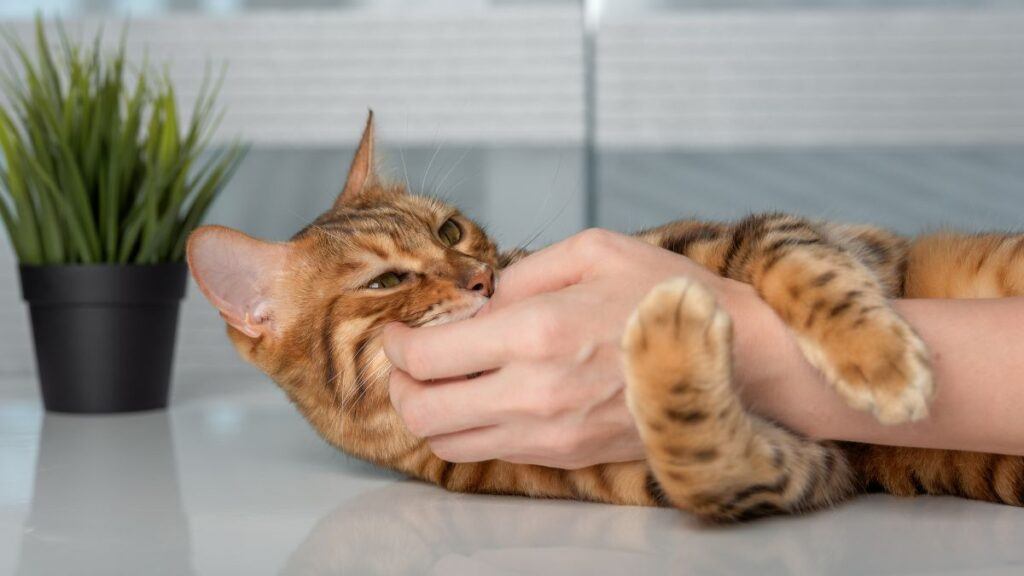This article explores the behaviors behind cat love bites versus real bites, shedding light on how pet owners can distinguish between the two.
Cats communicate in various ways, including through their bites, ranging from gentle nibbles to aggressive attacks.
Understanding these behaviors is crucial for responding appropriately to your cat’s needs and maintaining a healthy relationship with your furry friend.
Through a closer look at cat body language, interactive play, handling, and professional advice for more challenging behaviors.
This guide also aims to equip cat owners with the knowledge needed to navigate the complexities of feline communication.
Understanding Cat Love Bites and Real Bites

Cats use biting as a form of communication, but owners must recognize the difference between a friendly nibble and a hostile bite.
They are distinguishing one from the other aids in understanding and responding appropriately to a cat’s behavior.
Identifying Cat Love Bites
Love bites, or gentle nibbles from your cat, are typically harmless and part of their playful or affectionate behavior.
They may happen during a moment of bonding, such as when petting your cat. These love nips are usually light bites where the cat’s teeth barely press the skin and should not cause pain.
One sign of a love bite is that it often accompanies the cat’s purring or a calm demeanor.
Recognizing Real Cat Bites
Authentic bites, which can be painful, signify a cat feeling threatened or aggressive. T
hey often occur with less warning and come with a concerted effort to cause harm, pressing in deeply with their teeth.
A cat’s body language before a real bite might be stiff, with ears flattened and fur bristling. Bite inhibition is absent during real bites, meaning a cat intent on biting will use more force.
Distinguishing Between Playful and Aggressive Behavior
To differentiate between playful and aggressive behavior, observe the type and intensity of the bite. Aggressive bites are generally more forceful and may be followed by hissing, growling, or other signs of distress.
Gentle bites, on the other hand, won’t leave marks or penetrate the skin and will occur during moments of relaxation or play.
It’s important to note that repetitive gentle biting during play can escalate if the cat becomes overly excited.
A clue to a cat’s mood is its tail movement: a gently twitching tail usually signifies playfulness, whereas a rapidly flicking or puffed tail indicates aggression.
Behavioral Insights and Body Language

Understanding how to interpret a cat’s body language is essential for distinguishing between a love bite and a real bite.
Cats communicate their emotions through various signals, indicating whether they feel relaxed and affectionate or tense and aggressive.
Decoding Cat’s Body Language
Cats exhibit various body language cues that reveal their mood and the following possible action.
Observing these cues closely is crucial for their human companions to understand their feelings and intentions.
A relaxed cat will have a soft, loose body posture, and its tail may be held up with a slight curve at the top, signaling contentment.
However, subtle changes such as twitching tail movements or a tense body can indicate that the cat’s mood is shifting.
- Relaxed and Content:
- Soft body posture
- Tail held up, slight curve
- Eyes half-closed, blinking softly
- Head nudges and cheek rubs
- Tense and Uncertain:
- Tail twitching or thrashing
- Body tense or crouched
- Ears positioned sideways or back
- Dilated pupils, fixed gaze
Signs of Affection vs. Aggression
Differentiating between signs of affection and signs of aggression is key to understanding a cat’s behavior, particularly in the context of biting.
Love bites typically occur during a moment of affection, such as while petting, and do not cause harm.
These gentle nibbles are often accompanied by purring and kneading.
In contrast, real bites display aggressive body language, often accompanied by flat ears, hissing, or growling, and the intent to warn or inflict discomfort.
- Affectionate Behavior:
- Gentle nibbling without causing pain
- Purring and kneading behavior
- Soft, blinking eyes
- Relaxed posture
- Aggressive Behavior:
- Biting with intent to harm
- Ears flat against the head
- Hissing, growling sounds
- Stiff, tense body posture
Being able to interpret a cat’s body language helps recognize whether a bite is a sign of affection or an indication of petting-induced aggression or discomfort.
Observing a cat’s reaction to touch and respecting its boundaries can prevent unwanted biting.
Interactive Play and Handling

Understanding the difference between a cat’s love bite and a real bite involves recognizing how interactive play and handling influence their behavior.
Promoting Appropriate Play Behavior
Cat owners must distinguish between playful behavior and aggression in their pets. Interactive toys are a good idea for encouraging appropriate play behavior without stimulating play aggression.
Engaging a cat with toys mimicking prey, such as wands with feathers or mice on strings, allows it to exercise its hunting instincts in a controlled environment.
This not only diverts attention from hands or feet but also helps prevent rough play.
Positive reinforcement plays a crucial role in promoting good behavior. Rewarding a cat with treats, affection, or verbal praise after using toys helps reinforce that this is the preferred way to play.
Safe Interactions with Cats
Safe interactions with cats are critical for reducing the likelihood of a real bite. When playing with a cat:
- Use toys rather than hands or feet to avoid teaching the cat to play with them.
- Observe the cat’s body language, such as a twitching tail or flattened ears, which may indicate discomfort or irritation.
- Refrain from overly aggressive play, which can cause fear or anxiety, triggering a defensive response.
- Stop the play session if the cat’s play becomes too rough or if they show signs of agitation.
Through these approaches, both cats and their owners can enjoy interactive play that is safe, fun, and beneficial for the cat’s physical and mental well-being.
Contextualizing Feline Behavior
Cat owners often seek to understand their pet’s actions, especially distinguishing between affectionate love bites and aggressive real bites.
Understanding Life Stages and Behavior
- Life Stages: Cats exhibit different behaviors at various life stages, which their developmental needs can influence.
- Kittens: Often engage in play biting as they learn to socialize.
- Adult Cats: May bite to assert dominance or during heightened play.
- Social Learning:
- Mother Cat: Teaches young cat’s limits through bites.
- Pet Parents: Can use consistent responses to discourage biting.
Medical Conditions and Behavioral Changes
- Health Conditions: Can lead to a behavioral change such as increased aggression or biting.
- Example: Dental pain may cause a cat to bite if its mouth is touched.
- Behavioral Indicators:
- Sudden biting can signal underlying health issues; a vet check-up is advisable.
- Monitoring:
- Pet owners should watch for bite frequency or intensity changes, which could indicate medical conditions.
Understanding these aspects of feline behavior helps pet parents interpret their cat’s biting behavior more accurately.
Related: Cat Litter vs Pellets: Weighing the Differences for Your Feline Friend
Professional Guidance and Solutions
Understanding the difference between a cat’s love bite and a real bite often requires professional insight.
Cat owners should know when to seek assistance from behavioral experts and how to implement best practices for cat handling.
When to Consult a Professional
Cat behavior can be complex; sometimes, a love bite can escalate to a real bite. Immediate action should be taken if a cat’s behavior becomes aggressive or unpredictable.
It’s advisable to consult a certified cat behavior consultant or an animal behaviorist like Dr. Kelly Ballantyne from the University of Illinois.
Professionals can assess behavior, determine underlying causes, and help prevent future incidents. Owners should seek help if:
- The cat exhibits sudden changes in behavior.
- Bites are frequent, intense, or lead to injury.
- Traditional methods to discourage biting have failed.
Educating on Best Practices
Professionals can guide best practices to ensure the safety and well-being of both cats and their owners.
Implementing these practices requires patience and consistency. Behavioral experts can offer education on how to:
- Properly interpret the cat’s body language.
- Differentiate between playful nibbles and aggressive bites.
- Train the cat using positive reinforcement techniques.
- Reduce stressors that may lead to biting behavior.
Introducing Cory Haasnoot, a devoted father, loving husband, and enthusiastic cat lover. As a key content creator for CatFurLife.com, Cory blends his family values and passion for felines into engaging and informative content. He brings a unique perspective to the site, sharing cat care tips and how cats can enrich family life and bring joy to households.

